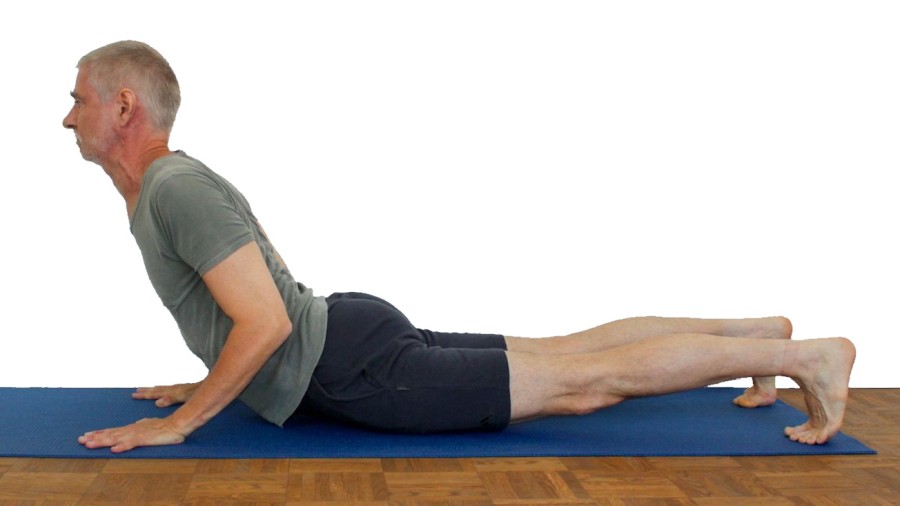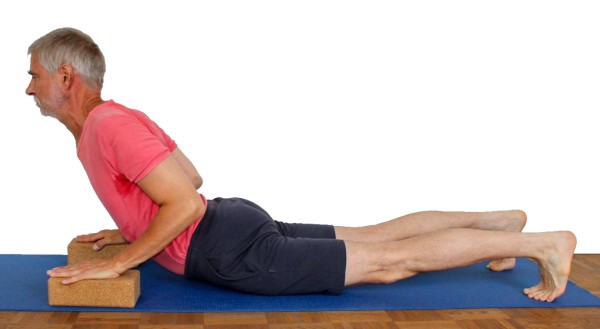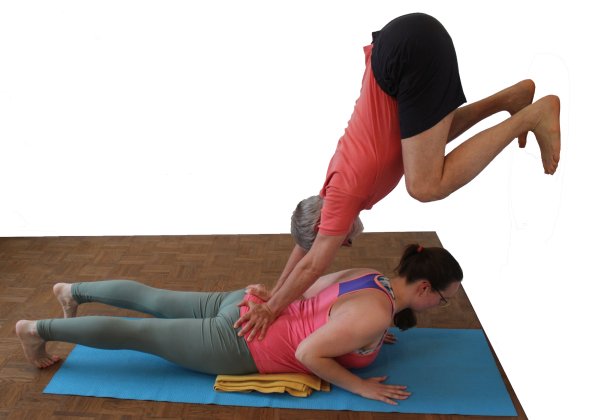yogabook / asanas / bhujangasana
Contents
bhujangasana
„cobra“

 instructions and details with working links as PDF for download/print
instructions and details with working links as PDF for download/print
Feedback: We’d love to hear what you think about this description, give us feedback at:
postmeister@yogabook.org
Last modified: 30.12.2018
Name: bhujangasana
Trivial name: cobra
Level: FA
- classification
- contraindications
- effects
- preparation
- follow-up
- derived asanas
- similar asanas
- diagnostics
- instructions
- details
- variants
Classification
classic: lying pose
physiological: upper body backbend, stretching of the hip flexors and abdominal muscles
Contraindication
In the case of facet syndrome, spondylolisthesis and spinal canal stenosis, this pose can easily lead to the reoccurrence of the respective complaints. The more restricted the flexibility of the hip flexors, the more this applies.
Effects
- (302) Strengthening the triceps
- (602) Strengthening the erector spinae
- (302) Strengthening the triceps
- (307) Strengthening the biarticular middle triceps
- (727) Strengthening the short hip extensors, e.g. gluteus maximus
- (812) Strengthening the quadriceps
- (671) Stretching the long abdominal muscle rectus abdominis
- (711) Stretching the hip flexors
Preparation
To warm up the shoulder, the strength of which is required here, practise:
- Downface dog as a general stretching of the shoulder
- Upface dog as a pose that prepares the shoulders for powerful work, especially through correctly executed transitions from and to downface dog
- Rectangular handstand to warm up the shoulder muscles
- Back stretching, especially the „elevated“ version as a general stretch for the shoulders
- Dog elbow pose
- Purvottanasana if the tone in the deltoid is too high or has become too high due to the preparation
Although the arms and shoulders should be used as powerfully as possible, a powerful extension in the hip joints is also necessary, simply so that the hyperlordosis of the lumbar spine does not become uncomfortable. This can be prepared with poses that prepare for the powerful use of the glutes:
- caturkonasana
- parsvakonasana
- hip opener 3
- warrior 2 pose
- purvottanasana
- warrior 3 pose
- „backwards against the wall“ variant of warrior 3 pose
and those with simultaneous stretching of the hip flexors:
- urdhva dhanurasana
- eka pada variation of urdhva dhanurasana
- setu bandha sarvangasana
- eka pada variation of setu bandha sarvangasana
and other various backbends.
To enable the pelvis to move into extension and to limit the hyperlordosis of the lumbar spine, prepare with:
with backbend:
and other backbends with hip extension.
The arms move slightly into retroversion in this pose. If this is difficult, prepare with:
If the lower back (lumbar spine) is under a lot of tension and is uncomfortable, you can do a few preparatory poses to reduce the tone:
- parsva uttanasana
- virasana forward bend (child’s pose)
- parsva upavista konasana
- parivrtta trikonasana
- parsvottanasana
- half lotus forward bend
- karnapidasana
If the muscles of the forearms tend to be stiff and the work in the palmar flexors and finger flexors is painful to stretch or there is a tendency to cramp in the dorsal wrist, practising these pose beforehand or in between will help:
With high tension in the triceps, there is a tendency to cramp in the middle, biarticular head of the triceps in this pose:
- upper half of gomukhasana with the arm that has cramped as the upper arm
Follow-up
If the lower back feels uncomfortable or strained after the pose, practise:
- parsva uttanasana
- virasana forward bend (child’s pose)
- parsva upavista konasana
- parivrtta trikonasana
- parsvottanasana
- half lotus forward bend
- karnapidasana
If there is a tendency to cramp or a cramp in the triceps:
- upper half of gomukhasana with the arm that has cramped as the upper arm
Derived asanas:
Similar asanas:
Diagnostics (No.)
(711) An excessively hollow back in this pose indicates a lack of flexibility in the hip flexors, which usually results in a tendency to a hollow back in everyday life. See the FAQ for the risks of a hollow back:
- hip opener 1
- hip opener 2
- warrior 1 pose
- upface dog
- urdhva dhanurasana (back arch)
- ustrasana (camel)
and other backbends with extension in the hip joint.
(650) kyphosis and lordosis of the spine:
Some deviations from the physiological double-S shape of the human spine can become visible here, e.g. hyperkyphosis of the thoracic spine, which does not allow the thoracic spine to be at least straight or extended as desired. Similarly, an excessive hollow back often indicates structural problems, see above and FAQ.
In extensive dorsiflexion and under greater load, issues of the wrists are most likely to become apparent:
- Ganglion, usually in the dorsal area between the hand and forearm, produces a sensation of pressure when the wrist is dorsiflexed
- Tendinitis of the tendons of the palmar flexors or finger flexors
- Carpal tunnel syndrome: worsening of symptoms in this position
- Fractures and fractures of carpal bones, especially the scaphoid bone
- Arthrotic change (degenerative with cartilage loss) of the joint
- Arthritis (joint inflammation) of various kinds
- Dislocation / subluxation, which would cause a significantly increased sensation of tension in various muscles covering the wrist
- Joint trauma, which may cause pain in the joint even after many weeks or months
but also purely muscular symptoms such as
- Shortening/hypertonus of the dorsiflexors of the wrist and finger extensors, which then become noticeable in the dorsal side of the wrist in the form of cramps.
- Shortening/hypertonus of the palmar flexors of the wrist, which causes stretching pain in the dorsiflexion of the wrist in the supporting muscles on the palmar side of the forearm.
- Golfer’s elbow: stress-induced pain at the point of origin of muscles of the inner ulnar side of the forearm in the transition to the upper arm.
Variants:
(P) rectangular handstand on the buttocks
Instructions
- Lie in prone position on the floor. Put your toes up and straighten your legs.
- Place your hands on the floor next to your shoulders so that your fingertips are roughly level with your shoulders.
- Press the pubic bones onto the floor and use the strength of the gluteal muscles to maximise the extension of the hip joints without bending the knees as you begin to stretch the arms.
- Keep the pubic bones pressed against the floor as much as possible while you extend the arms further and further, pushing the shoulder area upwards and backwards.
Details
- Make sure that the legs remain straight; the more forcefully you lift the upper body, the more the knees will want to bend because erecting the pelvis includes extension in the hip joints which via the iliopsoas pulls the knees towards the floor.
- Make sure that the pubic tuberosities remain on the floor with pressure, which means in particular that the pelvis does not lift from the floor to a upface dog. Raise the ASIS as high as possible.
- In this pose, again in contrast to the upface dog, the aim is not to stretch the arms but to maximise the extension or backbend of the hip joints and upper body by working the arm extensor triceps. In most cases – except for people who are very mobile in the hip joints – the arms cannot be fully extended, which is entirely in the interests of pose, but if they can, see the variation with blocks. This also depends to some extent on your body proportions. The elbows do not bend outwards but backwards. If the arms can be extended, the hands must be positioned further back, possibly up to the plumb line of the shoulder, in the taken pose.
- As always in backbends, if the lower back is too noticeable, it is advisable to use the glutes even more to bring the hip joints more into extension and thus the lower back less into hyperlordosis.
- Try to lift the inner knees more to compensate for the externally turning tendency of the legs due to the work of the gluteus maximus and the restricted flexibility of the hip flexors.
- Use the arm muscles instead of the back muscles to lift and bend the upper body backwards.
- Leep the arms loosely against the upper body, but don’t press them against it.
- As in many upper body backbends, a clear stretching sensation in the rectus abdominis can also occur here.
- Sometimes the difference between upface dog and bhujangasana is not clearly understood: In bhujangasana, the arms must not be able to be stretched through, in dog pose head up they must be stretched through – but not overstretched. In bhujangasana, the pubic bones remain on the floor; in dog pose head up, they are not on the floor but move towards the floor. In bhujangasana, the triceps are particularly active, followed by the pectoralis and the front deltoids; in dog head up, the palmar flexors of the wrist, the frontal abductor muscles of the shoulder joint are particularly active. The ability to push the body backwards and thus also the ankles into further and further dorsiflexion is much more pronounced in the dog head up. What both postures have in common, however, is that the knee joints are stretched intensively with the quadriceps against the bending tendency resulting from the pull of the iliopsoas and that the thoracic spine is extended, but less so through the strength of the autochthonous back muscles.
Known problems that can occur even when performed correctly
Discomfort in the lumbar spine
Depending on the constitution of the spine and the accompanying musculature, the pose can cause a certain degree of discomfort in the lumbar spine (usually the musculature) despite correct execution. Then there are often structural deficits in the back, see above.
Discomfort in the wrists
Depending on the constitution of the forearm muscles, the pose can cause a certain degree of discomfort in the wrist despite correct execution.
Cramp in the middle, biarticular head of the triceps
The combination of retroversion in the shoulder joint and extension in the elbow joint can cause the middle head of the triceps to go into cramp. If it does not help to move the hands a little further forwards, the extension movement may need to be performed with less force. The tendency to cramp can be reduced with gomuhkasana, which stretches the caput longuum of the triceps very well.
Variations
with blocks under the hands

Instructions
- Take the pose as described above, but place your hands on blocks.
Details
- If you have very good flexibility in the spine and hip flexors, you may always be able to straighten your arms, regardless of where you position your hands. Normally, as described above, the hands would be placed further back so that the arms can no longer stretch. However, this mechanism is not sufficient with very good flexibility, as from a certain point (wrists in the plumb line of the shoulders with the upper body raised to the maximum), moving them further backwards will only result in the shoulder area being raised less than it could be when the arms are extended, furthermore the wrists would also be forced into angles of dorsiflexion that they may not be able to bear. To make the situation more favourable, support with one or two blocks is necessary, which are placed under the hands so that the arms are not fully extended when the upper body is raised to the maximum.
- In principle, the increase also shifts the sarcomere length of the caput longum of the triceps in a more favorable direction. So, if there is a pronounced tendency to cramp there, this variant may be an alternative.
Known problems that can occur even when performed correctly
Tendency to cramp-like discomfort in the lumbar spine area
As described above, this tendency becomes more pronounced as the intensity of the exercise increases
(S) pulling on the shoulders

Instructions
- Take the pose as described above.
- The supporter stands behind the performer and carefully pulls the upper body by both shoulders further into the backbend.
Details
- In addition to the obvious fact that the hyperlordosis of the lumbar spine and thus the tendency to cramp-like back stress there increases with increasing pull on the shoulders, it is also important to keep an eye on and control the tendency of the knees to bend: the more forcefully (actively or passively) the extension in the hip joints is performed, the greater the tendency of the knees to bend.
Known problems that can occur even when performed correctly
Tendency to cramp-like complaints in the lumbar spine area
As described above, this tendency becomes more pronounced as the intensity of the exercise increases
(P) Rectangular handstand on the buttocks

Instructions
- Take the pose as described above with the head facing a wall.
- The supporter take a right-angled handstand against the wall behind the performer, pushing the performer’s buttocks away from his legs (and thus away from the wall) with his hands.
Details
- This support is quite similar to that in supta virasana, not only because the supporter performs a rectangular handstand on the performer, but also because in both cases the aim is to reduce flexion in the hip joints and promote extension. The only difference between the variations is in the areas on which pressure is exerted: here the pressure is exerted dorsally on the buttocks and in supta virasana ventrally on the ASIS.
- The supporter’s hands support their entire body weight. This is generally not a problem for the contracted gluteus maximus, but is more of a problem for the pubic bone region, which is why a sufficient amount of appropriate softening agents can be used, such as shoulder support plates, mats or blankets.
- In the case of irritation of the sciatic nerve, also in the context of deep gluteal syndrome (DGS)/piriformis syndrome, this position may be contraindicated if there is a risk of pressure being exerted on the irritated nerve with the hands.
- The supporter’s hands must not be placed too far cranially, firstly because the curvature of the contracted buttocks would then push the wrists into possibly impossible angles of dorsal flexion and secondly because the effective lever arm to the acetabuli, in which extension occurs in the hip joint, is too small then. Note that by far the greatest part of the force is transmitted via the carpus (near the wrist). Hands that are placed too far caudally harbour the risk of slipping.
- Of course, you should first check whether the type and amount of pressure on the buttocks seems acceptable to the performer and then carefully take the rectangular handstand
